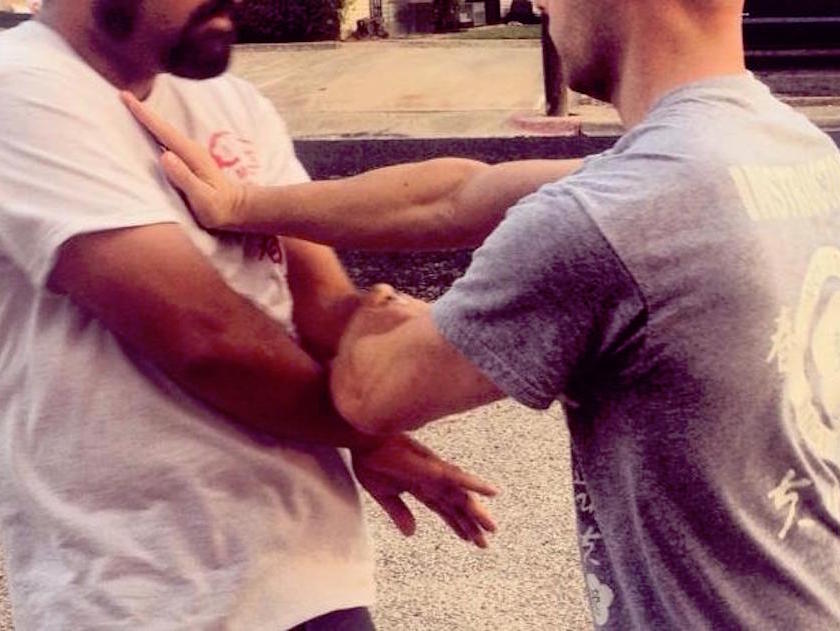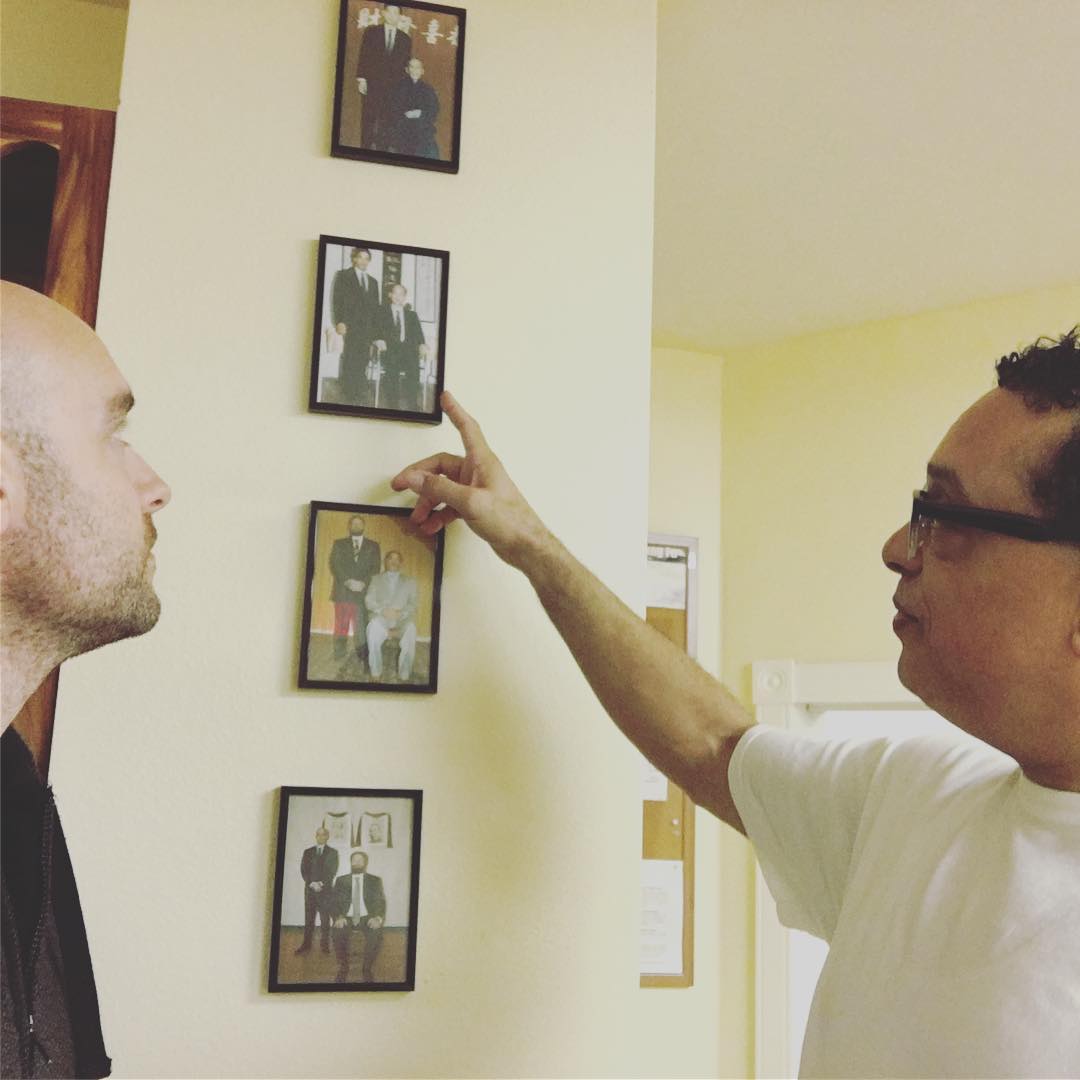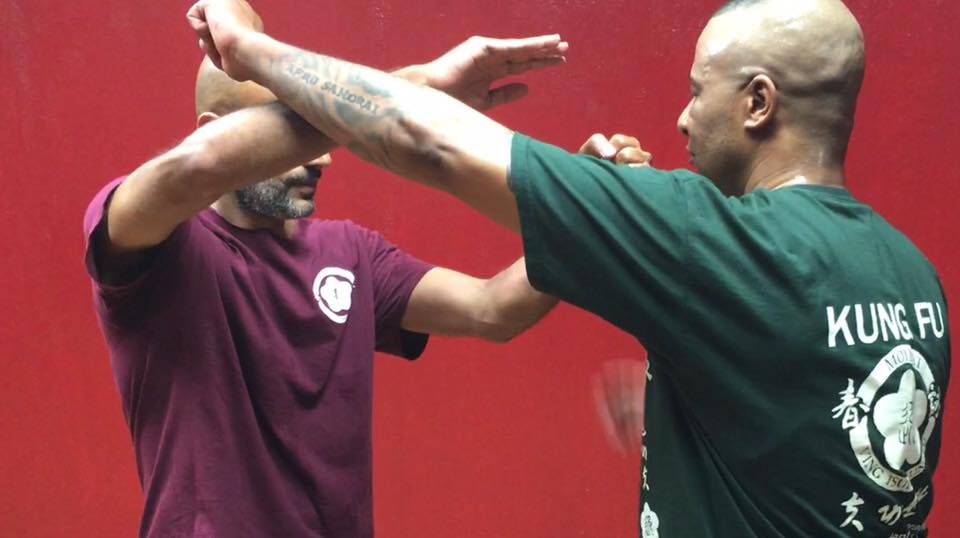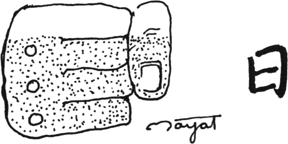By Nic Bartell | April 21, 2017

Centerline Technique
“Dominate the centerline; simultaneous block/trap and attack.”
Is Wing Chun Effective?
The short answer is YES, absolutely. To be clear, however, Wing Chun is not a style of fighting, but rather a system used to develop fighting skills. The system itself is extremely effective at developing your skill in combat and self defense. Like any other curriculum the skill of each individual student will vary, but for the serious and diligent student (let’s hope that this is you), the study of the Wing Chun system will develop an automatic self defense reflex. The system is designed to help you develop a set of basic fighting tools that when layered together lead to natural and instinctual movement that neutralizes incoming threats.
Because Wing Chun is designed for survival fighting and not competition, the focus of the training typically prioritizes techniques that are meant to end fights instantly without long rounds of back and forth sparring. Eye pokes, knee breaks, and throat strikes are extremely effective for ending real-life fights instantly. Additionally, most of the Wing Chun striking techniques are designed to occupy strategic space that makes it harder for an attacker to hit you back in a vital area with any significant force.
Is Wing Chun Effective for Self Defense?
For a true self defense situation it is probably the most effective martial art, because of the simple and straightforward nature of it. Less complication, less to go wrong. The techniques are specifically designed to help you be able to defend yourself against a stronger, larger attacker. The Wing Chun system focuses on techniques and strategies that do not rely heavily on size, speed, or athleticism. The techniques trained in Wing Chun are always viewed through the lens of assuming that your opponent is stronger, larger, faster, etc… so in a sense we are never training with the mindset of being the fastest and best, but rather understanding what is the most effective and devastating thing you can do in the moment to stop an attack dead in its tracks. You wouldn’t train to be able to beat a wild animal in a fight, but instead you train how to stop an animal from attacking you or how to injure it by knowing its soft spots and how to focus your counter-attacks to the most vital areas to stop the attack in the first place.
Self defense based on some canned responses like a groin kick or wrist lock are highly likely to fail in the moment, there are too many variables, so the best self defense training is how to be able to attack the attacker with deadly force so they are forced to retreat. No one stops attacking you because you are so good at blocking their attacks and no one canned response will be enough to stop a real attack; you must be able to turn the fight around and force the attacker to be on the defensive. This might sound like more than self-defense, but a main tenet of Wing Chun is simultaneous attack and defense. So each movement is purposeful to both limit incoming threat while simultaneously being on the offensive so the attacker is forced to protect themselves instead of continue attacking you.

Practical Kung Fu
“Authentic Ving Tsun will keep you healthy, strong, and safe.”
Is Wing Chun Effective in a Street Fight?
It makes more sense than any other art for street fighting. The 2 most important factors in surviving a fight is not falling down and being able to strike with knockout power, both of which are the 2 most practiced things in Wing Chun.
That said, the real purpose of the Wing Chun system is to help you develop habits of threat elimination and suppression. A simpler way to say that is that the system helps you develop instinctive fighting ability that does not rely on predictable patterns; in a real-world fight or attack the setup is nothing like a sparring mach or a toe-to-toe standoff; when you get attacked you probably will not know who, when, or how they are going to come at you. Winning the fight has to do with reprogramming yourself to automatically position yourself to always have advantageous position, posture, distance, outlook, perspective, and the ability to out-threaten the threat. Wing Chun training develops these habits in a way that actually decreases your likelihood to need to fight, but greatly enhances your ability to fight when necessary. The ultimate goal of training the system is to feel relaxed and confidant in your actions because you become more aware of what is real vs apparent threat and walk around with the ability to effectively engage with and eliminate those threats. The Wing Chun system has a heavy focus on repetition, so each technique in the system is studied in depth and from all the angles. This approach to thoroughly understanding base techniques gives you a fighting skillset that has real depth and the tendency to feel in tune with those techniques as a part of your own movement as opposed to some techniques that you know but can’t really use.
Is Wing Chun Useless?
Most people are unaware of the fact that Wing Chun is the original mixed martial art that took the greatest known fighting techniques and put them together to form a system that could prepare battle ready warriors faster than any other system of training. Wing Chun is the system that Bruce Lee studied before becoming known throughout the world and eventually inspiring the birth of the modern mixed martial arts movement.
If you think Wing Chun is useless either you have not seen or experienced real Wing Chun or you have heard someone’s opinion about Wing Chun being no good. Because of the popularity of its name there are many people who claim to teach Wing Chun but in many cases it’s taught as a secondary curriculum within an already existing martial arts school or the form of it that is being taught is not complete or pure. When the instructor of an existing martial arts school goes and get’s certified to teach Wing Chun but is not truly a Wing Chun disciple the form of what they teach should not really be considered Wing Chun. It is therefore critically important to differentiate between the Wing Chun techniques you might learn at any given martial arts school versus those you will learn at a dedicated Wing Chun only school.
When you practice diligently with the guidance of a qualified Sifu, Wing Chun is an extremely effective form of fight training that develops automatic, instinctive fighting skills designed specifically for combat as opposed to competition sports. Wing Chun focuses on the most useful, powerful, and high probability techniques that you will need to survive a real life attack.

Ving Tsun Form
“Students Studying the Ving Tsun (Wing Chun) Form”
What Question Should I be Asking?
Most martial arts have some circumstance that they were designed for. So if you’re looking for a martial arts school the most important thing you can do is make sure that the purpose of that martial art matches yours. People do martial arts for a variety of reasons. Some people want to learn to fight and some people seek competition. Some people are interested in martial arts purely for the mental and physical benefits. Others are simply looking for something to do and get some exercise. Most people are looking for some combination of the aforementioned things but really you need to decide what is the most important factor first.
If your main purpose is competition then Wing Chun may not be the best fit, not because the art won’t work for that but because most Wing Chun schools do not focus on competition or strategies that were developed for competition. Wing Chun schools are 99% dedicated to developing martial arts skills geared towards real life self-defense situations. It may be hard for a novice practitioner to understand the difference but I think there’s a couple things that might help clarify. One example is the tendency for people to practice training on the ground. If you train on the ground and become comfortable on the ground you may have the tendency to want to take a fight to the ground and if that is your go to strategy then you’re really setting yourself up for disaster in the real world. Most fights don’t happen on mats and there’s nobody there to keep other people from jumping in while you are so tied up with your opponent on the ground. You may injure yourself just taking the other person down on a cement floor or you might get kicked in the teeth by a bystander while you’re trying to choke somebody out.
Another example is martial arts that focus too heavily on sparring and mock fighting. The truth is that sparring is fake fighting and if you’re doing fake fighting you’re building up an unrealistic confidence in your real fighting ability. The strikes that you may able to withstand when your opponent is wearing gloves are not strikes that you can necessarily take out on the street. Sparring often turns fighting into what looks more like a boxing match which is just not how fights really happen. When you’re wearing gloves it changes the way you attack and you’re practicing a style of attack that doesn’t really allow you to use your anatomy to the fullest. A fist can take a lot of shapes but when that fist is wrapped in a glove it is easy to ignore just how important even having the ability to properly make a fist is. Most people think they already know how to make a fist because it seems like it’s obvious, but when you study a martial art like Wing Chun you look deeper at things and understand how subtle details can make a world of difference.
In terms of strategy when you train a martial art that is designed for competition the first step is already wrong. If your mindset is that there will be a winner and a loser then you will subconsciously treat all fighting as competition. Real fighting is about life preservation, when it’s a real fight the stakes are different and the possibilities of what might happen are boundless. Training a martial art that is designed specifically for real world fighting and self-defense changes the way that you think about threat, conflict, violence, and resolution. Surviving a real life altercation is not about winning but it is about ending or eliminating the fight. A competition mindset will completely gloss over this by only focusing on what it takes to best the other person as opposed to eliminating the threat. Threat elimination can take many forms, sometimes it’s a knockout, sometimes its taking the higher ground, sometimes it’s walking a different path, sometimes it’s having enough self-control to move away from something that leaves everyone broken.
So what is your purpose? If your purpose is being able to protect yourself and your family and you could care less about accolades and competition, then Wing Chun might be just what you are looking for. Wing Chun Kung Fu is hard work, but it will reward you in many ways: fighting ability, relaxation, peace of mind, balance, strength, power, energy, clarity, and health. The Wing Chun system is designed first and foremost for fighting, but the study of its form will yield much more and will impact your life in many positive ways.

Direct Lineage
“Be wary of any Sifu who says lineage isn’t important.”
Is Wing Chun Effective in MMA?
Yes, you just don’t hear about it because the other martial arts have adopted many of the concepts and technique from Wing Chun. That said, Wing Chun is typically not studied with tournaments or competition in mind, therefore, the focus is often techniques that other martial arts ignore because they can’t be used in competition, e.g. thrusting the fingers into the eyes or other strikes that don’t make sense when wearing gloves.
If you are looking to expand the skills you have developed from your previous MMA training then Wing Chun can enhance the arsenal that you already possess, but if you are considering training MMA vs Wing Chun you have to understand that the goal of the two training methods is much different. MMA is designed for the ring and for one on one fighting; ground and pound strategies are outright dangerous in real life situations as they leave you vulnerable to outside attack.
Wing Chun like most other striking arts is specifically designed to deal with multiple attackers and surviving a confrontation in the street as opposed to focusing on techniques that make the most sense for a one on one match with a specialized set of rules. In many cases there may be some conflict in what the two styles prioritize in terms of strategy. For instance if you train the habit to go to the ground this may work in a one on one cage match, but going to the ground in a street fight might put you in a position to get stomped on by your opponent’s friends or some other violent bystander. In a street fight the strategy is to destroy, but be able to flee at any moment. You cannot pigeonhole yourself into a position that limits your freedom and could result in being overcommitted to one opponent. What you train becomes your habit, so you must chose wisely what you want to get comfortable with.

Center Facing
“Center Facing allows for Simultaneous Blocking and Striking”
Wing Chun vs Muay Thai
Both Wing Chun and Muay Thai are formidable martial arts. Both arts focus on standup striking and use a combination of kicking, punching, elbows, and knees as their primary weapons. Some of the differences you will see are in the areas of footwork, distancing, facing, and commitment of force.
One of the most visible differences between Wing Chun and Muay Thai that you will see is the stance. Where the Muay Thai stance looks more like that of traditional boxing with one shoulder forward and one back Wing Chun is typically seen with a center facing stance with shoulders held square with the opponent. Each art has an explanation for its form; Wing Chun uses the square facing stance to aid with simultaneous attack and defense (since both arms have the same reach) and to better protect the back when compared to a side facing stance. The Wing Chun stance is also noticeably lower which works well to sink your center of gravity to help avoid takedowns and couples nicely with Wing Chun’s footwork which focuses on having solid footing with powerful in and out movements for disrupting the balance of your opponent.
Muay Thai footwork works mostly to support proper distance for the heavily kicking based art and also to absorb incoming kicks, where the footwork in Wing Chun is used primarily to adjust distance to support the application of pressure on your opponent through the hands. This pressure is used to trap the hands of your opponent while simultaneously striking them with a free hand or foot.
Since Muay Thai focus heavily on kicking, the range most Muay Thai fighters will feel more comfortable fighting is at a kicking range. While Wing Chun also trains at the kicking range it does not typically prioritize maintaining that range. Wing Chun practitioners usually train to close the distance and get to a range where they can deliver penetrative strikes to the areas around the throat and nose. This closing of the distance is necessary for a smaller attacker to be able to get to a striking range where they can actually deliver a blow to a taller opponent. If a shorter person stays at a longer range they are at a disadvantage against a larger opponent.
Muay Thai relies more on kicking than hand strikes and Wing Chun has much more emphasis on striking with the hands and using the legs for power, balance, and stability. Wing Chun also studies kicking but typically prefers to leave 2 feet on the ground to maximize stability and mobility and not be left in the vulnerable position of only having one foot on the ground. Both styles study the use of elbows when at a close range.
A very obvious difference in the two arts is the commitment of energy. You will see Many Muay Thai techniques where the emphasis is more on the delivery of power than in Wing Chun where the delivery of power takes a backseat to stability and neutrality. Many times a Muay Thai kick might miss and the kicker be forced to spin around to recover, where in Wing Chun you will rarely see a strike with so much intent that the fighter is forced to turn or put their foot down in a way that compromises their balance or posture. With Wing Chun’s heavy emphasis on simultaneous attack and defense you will rarely see an offensive Wing Chun technique preformed without any consideration for how it leaves the fighter open after it has been executed.
Both styles are effective for fighting and in the end the art that keeps you motivated to train is the most important factor, but when it comes to techniques that will work regardless of your inherit age, size, strength, and athleticism, Wing Chun is an art that can work effectively for a wider swath of the population. The techniques in the Wing Chun system are specifically designed to function without the need for top physical conditioning and in many cases make more sense for someone looking for skills they can rely on for the rest of their lives.

The Ving Tsun Fist
“There is a lot more to making a fist than just clenching your hand.”
Wing Chun vs Boxing
Little known fact: Wing Chun is known by other names, most notably Chinese Boxing. So what are some of the main differences between the two styles of boxing? For one Chinese Boxing uses both punches and kicks whereas western boxing is typically limited to hand strikes only. Also, because of the tendency for western boxing to be trained while wearing gloves much of the techniques of fist construction and open hand striking positions are completely ignored. Since boxers don’t typically train kicking their defenses for kicks are completely ignored.
A well trained boxer can be deadly with their hands, western boxers can develop tremendous power with their punches, but with that power comes the likelihood for hand injury. Wing Chun training focuses heavily on training the shape and construction of the hand techniques to both protect the hands from injury and to focus the power in the attacks for greater penetration into soft tissue. The defense in western boxing is mostly bobbing, weaving, slipping, and in some cases blocking with the gloves. Wing Chun puts much more emphasis on using the hands to deflect incoming strikes and using the hands to not only strike but also grab and trap your opponents hands to limit their offensive capabilities.
If you watch a boxing match you will see a fair amount of waiting for the right moment and offensive forays going back and forth. The Wing Chun strategy differs in that there is typically a greater emphasis on trapping the hands and creating an opening as opposed to waiting for one. Instead of keeping the hands up in front of the face to be ready, a Wing Chun practitioner will typically use those hands to be jamming their opponents hands and thus their offensive weapons. Wing Chun is most notably known for simultaneous attack and defense which basically means one hand is pinning their arms while the other hand is striking as opposed to blocking with one hand and then counterattacking with the other.
If you are trying to decide which art to train then finding your purpose is the first step. If you are looking for a sport with competition then western boxing makes the most sense, if you are looking for self defense then Wing Chun is the way to go. Both arts will each you to fight, but the strategies of fighting are different depending on if its a competition or a fight for your safety. In a street fight there will not be any gloves which drastically changes what techniques make sense and will be most effective.
Want to Learn More?
The best way to get a feel of what Ving Tsun (Wing Chun) is really about, is to participate in a class at our school. We have an introductory program that includes two classes (one private lesson and one group lesson). Participating in this program will give you a really good idea of what we do and its practicality. You can sign up for that program via the links below.

